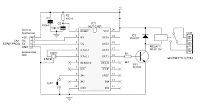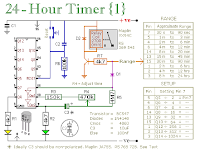A simple astable timer made with the 555, the mark (on)
and space (off) values may be set independently. The timing
chain consists of resistors Ra, Rb and capacitor Ct. The
capacitor, Ct charges via Ra which is in series with the
1N4148 diode. The discharge path is via Rb into into pin
7 of the IC. Both halves of the timing period can now be set
independently.

Timer Circuit
Timers are fundamental building blocks, and as such timers
are found in practically every electronic circuit. There are
many kinds of timers, available off-the-shelf from resellers of
electrical and electronics goods, because circuits circuits
involving timers have thousands of practical applications.

Timer circuit
The erasing time of an EPROM variate about 10 to 40 minutes.
It is a pity to waste our time to waiting it while watch the clock
round until the EPROM has to be erased. Here a circuit to get
the perfect time while it is erased, we can do some another
work and let the eraser work by it self. Figure I-2. shows
this timer circuit diagram.

ames timer
Although the diagram looks complicated, you should be able
to identify the important sections of the circuit. Look first for
the 2-pole 6-way rotary switch. Pole A is used to select the
appropriate value for RT . Only one of the timing resistors can
be in the circuit. For example, if the switch is operated so
that the 18 kW resistor is selected, the timed interval will be 1
minute.

CMOS 24.055 Hour Timer
The resulting timer circuit is made from a CD4060, includes an
oscillator and a 14 stage binary counter, two CD4040's, which
are 12 stage binary counters, a CD4012 Dual Nand gate and
a CD4013 Dual D Latch.
The CD4060 is connected to a 32768 Hz ECS 3X8 tuning form
crystal. The 10 Meg Ohm resistor between CD4060 pins 10
and 11 are to bias the internal inverter into its analog region,
and the 330 K resistor in series with the crystal is to limit the
power to the crystal. This setup is directly from the ECS
data sheet. The output of the 14th flip flop in the CD4060
appears on pin 3, and it is a 2 Hz square wave. A 2N4401
buffer drives a green LED with this square wave. When I
see it blinking through the plastic window of the Irrigation
System Controller housing, I know that power is on, and
that at least the oscillator and first 14 counter stages are working.

Electronics timer by CD4060
This is an electronics timer by CMOS CD4060 which is CMOS
14 Stage Ripple-Carry Binary Counter/Divider and Oscillator.
Two 24-Hour Timer Circuits
These two circuits are multi-range timers offering periods of
up to 24 hours and beyond. They can be used as repeating
timers - or as single-shot timers. Both circuits are essentially
the same. The main difference between them is their behaviour
in single-shot mode.
In single-shot mode - when the preset time has elapsed - Version
1 energizes the relay and Version 2 de-energizes the relay. The
first uses less power while the timer is running - and the
second uses less power after the timer has stopped. Pick the
one that best suits your application.
These two circuits are multi-range timers offering periods of
up to 24 hours and beyond. They can be used as repeating
timers - or as single-shot timers. Both circuits are essentially
the same. The main difference between them is their behaviour
in single-shot mode.
In single-shot mode - when the preset time has elapsed - Version
1 energizes the relay and Version 2 de-energizes the relay. The
first uses less power while the timer is running - and the
second uses less power after the timer has stopped. Pick the
one that best suits your application.

Repeating Timer
The Cmos 4060 IC has two built-in inverters - at pins 9, 10 and
11. They must be wired together to form an oscillator - the
output of which is at Pin 9.
While the oscillator is running - Pin 9 is switching continuously
from high to low and vice-versa.






